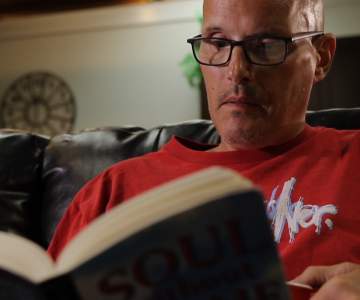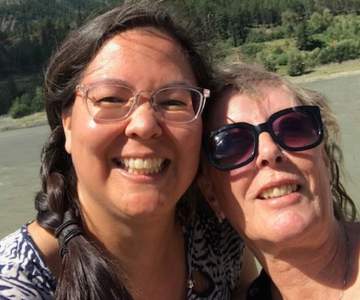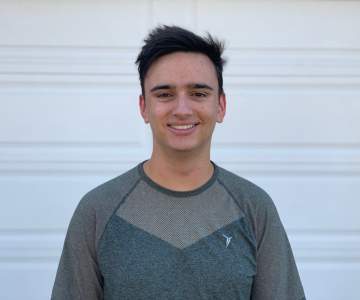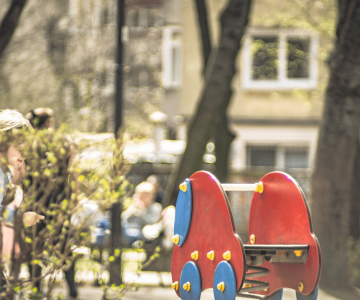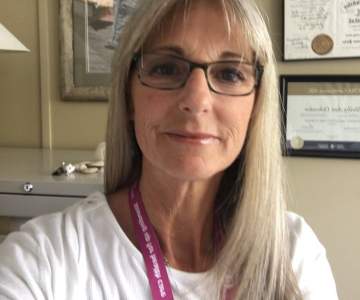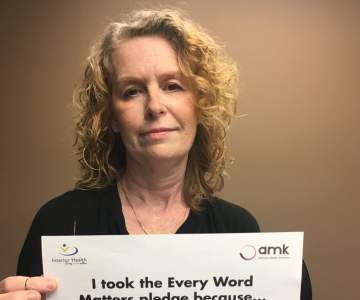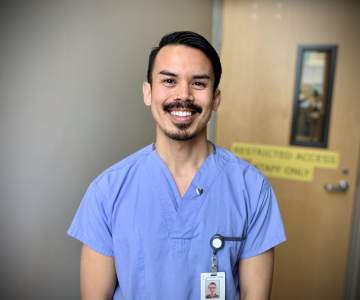Breadcrumb
Explore Stories
2 Minute Read
Community & Culture
Brian is a familiar figure in his community. He is an avid reader who enjoys hiking and is sometimes seen walking with his pet Bearded Dragon draped over his shoulder.
“I love her. She keeps me out of trouble,” he says affectionately. “She was quite small when she was born - she was a runt. I wasn’t sure if she was a boy or a girl, so I named her Sasha.”
He is involved in multiple volunteer projects, such as community clean-ups and anti-stigma work, and provides harm reduction support at the local outreach centre.
“I volunteer doing outreach, giving out harm reduction supplies. I teach people how to use Naloxone. I work at the Cammy Lafluer clinic. I like to help out, steer someone away from using drugs if I can, but if not, I’ll teach them how to do it right, to be safer.”
Brian’s story began in a Vancouver hospital where he was born with serious health complications due to his biological mother’s heroin and alcohol use.
After spending the first year of his life in hospital, Brian was adopted. He grew up in Cranbrook, doing “normal kid stuff” like playing soccer, riding motorbikes, and fishing. But it was never easy.
“I was always awkward. I felt like I was in the way, like I didn’t fit in,” he recalls.
That feeling changed the first time he experienced an opioid. As a young teen he was given morphine in hospital following an injury. For the first time in his life, he says, Brian felt normal…like he belonged.
It is a sentiment supported by substantial research. "Literature shows a connection between trauma and opioid use. We know that early childhood trauma - like being in a hospital for a year - changes the brain and makes it vulnerable to the effects of opioids," says Interior Health Substance Use Director Corinne Dolman.
It was the beginning of a longstanding dependency on opioids, which Brian has managed with prescription methadone for more than 30 years.
“I’ve definitely been impacted by stigma. I see it every day.”
“Just accept people as they are. Just treat people the way you want to be treated.”
“It’s that simple.”
Watch the video and share Brian’s story. Check out more resources about stigma and substance use. Help #EndStigma.
Brian's story is part three in a four part series of stories and videos about the stigma faced by those impacted by substance use.
2 Minute Read
Health & Wellness
"There are only so many ways to fix a broken leg," says Debi Morris. "But if you have five patients with a mood disorder, there will be so many ways you will approach treatment."
For Debi, the field of Mental Health and Substance Use (MHSU) is fascinating, in part, because care and treatment needs to be individualized to be effective. What may be recovery for one person will be different for another person.
"It's the epitome of patient-centred care because if we're not [individualizing treatment], we're not going to get the outcomes that we need for people."
Debi serves IH West as the MHSU Administrator. Aboriginal Health Lead Vanessa Mitchell interviewed Debi recently for the Interior Voices podcast series. The pair discussed the importance of patient-centred care and reminisced about the time they spent together last summer on the Nlaka'pamux communities tour.
Vanessa Mitchell points out this approach very much aligns with trauma-informed practice and culturally safe practice. The Nlaka'pamux communities tour afforded managers like Debi the time and experience to see firsthand the unique health challenges experienced in communities.
"We have a lot of conversations in our day-to-day work about access," Debi says. "But if someone lives on a gravel road fifty kilometres or more from the nearest services, what does that look like compared to someone who lives in downtown Kamloops?"
Spending time in communities is also an important step towards building relationships and "relationship is a pathway to removing barriers in and of itself," says Debi.
To hear the full conversation and learn more, tune in to Interior Voices.
Listen to the podcastInterior Voices is a podcast that explores the intersection of health and culture in the workplace, everyday lives, and patient care. While it was created to help expand IH staff and physician engagement around cultural safety, many episodes will also interest community members. The series includes interviews with IH staff, physicians, and others living and working in the Interior region.
1 Minute Read
Health & Wellness
Jonathan Green is a recent high-school grad from Kelowna. His mom is also a physician at the Urgent and Primary Care Centre in town. As part of a recent class project he created a video to help spread the word about staying safe and protecting ourselves against COVID-19.
"I see my mom going to work every day and I just want her to be safe," says Jonathan. "So for her to be as safe as possible, I want to help spread the message of physical distancing and other precautions like staying home when sick and wearing a mask when distancing isn't possible."
Watch Jonathan's video and learn more about protecting yourself and your loved ones from COVID-19 by checking out our trusted information.
2 Minute Read
Community & Culture
We Are IH is a new recognition campaign to spotlight our people in a real way – through pictures and stories that allow their authenticity to shine through! Each month, four Interior Health employees or medical staff will be featured through our News@IH website and our weekly In the Loop Roundup email newsletter.
Vanessa Mitchell is an Aboriginal lead and program manager of the Journey to Aboriginal Cultural Safety program. She has worked at the Vernon Health Centre for five years.
Vanessa's life has been inspired by her ancestors and warriors, past and present, and their vision and fortitude to stand strong to ensure Indigenous peoples could hold positions of influence, such as her integral role here at Interior Health. Her philosophy of "hard work and heart work" is the driving force behind all the energy she gives to both her community and career.
Vanessa truly loves her family, community and Nation for their humour, resilience and heart that brings laughter and love into her daily life.
"The work of Cultural Safety and Humility is hard work and heart work."
Vanessa's favourite inspirational quote.
In the book We Get Our Living Like Milk From The Land, Sqilxᵂ (pronounced skay-lugh) is defined as the original people who learned to live together on the land in peace. As a Sqilxᵂ, this connection is held close to Vanessa's heart, as it always reminds her of who she is and where she came from.
Born and raised in the Okanagan/Syilx community and Nation, Vanessa has continued to give back to her community in her adult life as she has created a home for her family where she was raised.
As an Okanagan/Syilx woman, mother, and daughter, Vanessa understands first hand how much hard work and heart work goes into her career and community. Being acutely and intricately knowledgeable of Indigenous people, families, communities, and Nations with personal living experiences of cultural unsafety and racism, she balances both the hard work and heart work.
Check back each Friday for the next We Are IH feature.
For more information contact EmployeeExperience@InteriorHealth.ca.
Vanessa's nomination of Rose Melnyk keeps the loop going:
"Rose is a strong Secwépemc woman grounded in who she is and where she come from, with clinical front-line experience as an RN within IH whose heart is with the people and specifically with the Elders."
3 Minute Read
Health & Wellness
Have you ever thought what would improve the quality of life for people living in your community? What would make your community a better place to live? What matters most to you? Sharing your ideas, visions, and views during an Official Community Plan (OCP) process is a perfect opportunity to engage in local government planning to help shape your community.
Every 5-10 years, local governments must update their Official Community Plan. An Official Community Plan (OCP) is a bylaw, which contains goals and policies that guide land use into the future. The OCP reflects the values and priorities of the community. It serves as a guiding document for city staff and elected officials when making decisions about many aspects of community planning. Community planning with health in mind provides more opportunities and reduces barriers for all people to live healthy lives.
Research shows that approximately 60% of what influences our individual health is related to elements found within our everyday lives and the environment that we live in[1]. An OCP has the ability to significantly impact the way our communities are planned, and therefore significantly influence the individual health of community members. A healthy community is when the built, social, economic, and natural environments are well balanced to allow people the opportunity to live to their full potential and come together to make their community better for themselves, their family, friends, neighbours and others. Read the Link between planning and health: Official Community Plan for more information.
Best practices to support healthy community development include:
Compact and complete communities support walking, cycling, and use of public transit over cars. This leads to improved health outcomes, better physical and mental well-being, and greater opportunities for social connectedness.[2]
Prioritize diverse housing forms, tenure types, and mixed income development. Unstable housing can lead to poorer health outcomes. Stable and affordable home provides warmth, safe, and healthy environment to support your health as well as foster good mental and physical health and improved quality of live. Read Health & Housing Backgrounder & Case Study for more information.
Agriculture directly impacts health by influencing food choices and healthy eating patterns. For example the presence of local farmers’ markets encourages people to eat more fruits and vegetables.1
As a member of the public, it is important to become involved in local government planning. Local governments must consult with the public on planning and development processes. Visit your local government webpage to find out more on how you can become involved today – they often have a newsletter you can sign up for to receive updates.
Right now, the City of West Kelowna is in phase 1 of its OCP Update to create a new community vision and is seeking input from anyone that lives, works, or visits West Kelowna. Visit ourwk.ca to learn more.
For more information on the link between health and planning visit:
www.planh.ca
www.thinkupstream.net
[1] Canadian Medical Association. Health Care Transformation. 2013.
[2] BC Center for Disease Control. Healthy Built Environment Linkages Toolkit: making the links between design, planning and health, Version 2.0. Vancouver, BC. Provincial Health Services Authority, 2018.
5 Minute Read
Community & Culture
We Are IH is a new recognition campaign to spotlight our people in a real way – through pictures and stories that allow their authenticity to shine through! Each month, four Interior Health employees or medical staff will be featured through our News@IH website and our weekly In the Loop Roundup email newsletter.
RN Shelley Ockenden is an Occupation Nursing Support Services Coordinator and recent long-term service award recipient after working at the Kamloops health unit for 33 years.
A country girl at heart, Shelley was born and raised on a cattle ranch in Ashcroft, B.C. before spreading her wings and settling in Kamloops where she has lived for the past 32 years.
Shelley followed her passion and love of working with children and their families as she developed her career, supporting children with special health needs and children in palliative care. Although Shelley would fix something for someone if she could, she learned that the best way to "fix" things for people is to imprint a memory of caring, alongside their hurt and their grief.
Shelley created positive change in the lives of the people she surrounded herself with including those within Interior Health. The initiatives she led including the resources she created, Supporting Families through Perinatal Loss Quick Guide and Leaning into Your Discomfort - How to Support Someone Who is Grieving, are a legacy that will continue to help people beyond her time at Interior Health. (Note: links accessible only within IH network.)
Fun is one of the many positive words people use to describe Shelley and we know that with her attitude, each and every day of her retirement will be full of fun!
Shelley wants to thank Interior Health and everyone who has worked alongside her as it's been a very memorable journey.
We will sincerely miss you, Shelley! Thank you for all that you've done! Cheers to an amazing 33 years together, you've touched the lives of so many people and we are so grateful for your service.
Check back each Friday for the next We Are IH feature.
For more information contact EmployeeExperience@InteriorHealth.ca.
Shelley's nomination of Cathryn Goodman keeps the We Are IH loop going:
"Because although she is newer into her role as manager Cathryn has made it a priority (in the time of COVID-19) to really try to get to know and support her team members."
4 Minute Read
Health & Wellness
Having spent the past 20 years working as a Speech Language Pathologist in Salmon Arm, Christina El Gazzar had been searching for a way to give back to her community.
Originally from Montreal, she had relocated to the Shuswap from northern B.C., accepting a job with Interior Health and moving with her family. For the next two decades, Christina first worked as a frontline Speech Language Pathologist (SLP) and is now a professional practice lead, supporting those in the community with speech and language issues.
But she wanted to do something meaningful for the community. Enter the Salmon Arm Boxing Club’s Hit 2 Fit Challenge.
Christina had already taken up the sport of boxing as a way to get in shape. The club challenge would allow her to share a passion for supporting speech and language development with the community and combine it with the sweet science of boxing.
“The boxing club’s challenge had three elements to it: Get in shape, raise money for something near and dear to you and then you could get in the ring, if you wanted,” explains Christina. “It really checked all the boxes for me. I had been boxing for a few years to stay in shape, but I wasn’t doing it enough. I wanted to do it four or five times a week so I accepted the challenge.”
Finding something near and dear to her heart was easy. She would raise funds to install a communication board at Salmon Arm’s universally-accessible Blackburn Park.
“Young children with communication challenges need support in order to express the most basic of human needs, such as making requests, conveying emotions and socially connecting with others,” she wrote to Salmon Arm council, seeking permission to raise funds and have the board installed in the city park. “Communication happens everywhere. Having a communication board at Blackburn Park will provide these children with the supports they need to be successful in this setting.”
Eight-year-old Connor in front of the communication board at Salmon Arm’s Blackburn Park.
The boxing club’s fundraising gala was to take place in May 2018, which also happened to be Speech and Hearing Month. So Christina went to work with her colleagues and with support from the community to put her plan in action.
Once the city was on board and council had approved, she approached community groups in town, soliciting sponsorship from the Salmon Arm Bulldogs Boxing Club, the Shuswap Community Foundation, Salmar Cinemas, the Salmon Arm Rotary, the City of Salmon Arm as well as the former mayor, Nancy Cooper.
Colleagues and Pediatric SLPs Julie Lewis and Bonnie Johnson came on board to work on the board, establishing the core vocabulary that would help youth communicate. They connected with and received input from various children’s groups in Salmon Arm and raised enough money to have the sign built.
“There are kids with communication difficulties who go to the park and this is something they can use,” says Christina. “It also raises awareness with the public. If they see the board and start talking about it, it reminds us all that there are young people everywhere who struggle with communication.”
Two years to the month that Christina accepted the boxing club challenge, this past May, the communication board was installed at Blackburn Park in Salmon Arm. There are two sides, one for younger kids and one aimed at older youth, who can point to images on the board to aid with communication.
Parent Nadine Kowaski is familiar with the speech language therapists in Salmon Arm. Her son, eight-year-old Connor, has autism and uses a picture exchange system to communicate on his iPad. A similar system of visual cues is used on the communication board.
“Having the board at the park is great,” says Nadine. “It inspires good communication among families that not all kids are verbal. I think it will be amazing, not only to help them communicate, but also bringing about community awareness of kids with diverse abilities with communication. I appreciate their hard work. The speech language pathologists in Salmon Arm are always going above and beyond.”
As for the final part of the challenge, stepping into the boxing ring, Christina also took that on, winning a unanimous decision after three one-minute rounds of boxing, as part of a gala fundraiser night.
“I didn’t decide to get in the ring until close to the gala. It was nerve-wracking. I did it once and am now retired from competition,” she laughs. “I am just thrilled that this project is now completed and can help young people communicate.”
The communication board uses visual cues to allow for enhanced communication for youth with diverse communication abilities.
Side 2.
3 Minute Read
Health & Wellness
Ryan knew he had a problem. As a teen he had experimented with drugs. That experimenting had quickly escalated into an addiction, and he needed help.
But as a popular boy growing up in a tight-knit community, he was worried about what people would think. Like most of us, Ryan had been exposed to negative stereotypes about addiction, compounded by language like “junkie” and “crackhead”.
“In trying to get support and help in the community, he was very concerned that people would know his secret and treat him badly. He’d grown up hearing those words. He had friends whose parents worked in health care and he was terrified that they would find out,” says Ryan’s mother Sandra Tully, co-chair of Addiction Matters Kamloops.
“I was desperate. I finally convinced him to go to into treatment. I got in touch with the intake nurse and, sure enough, it was someone we knew. I started to cry. I was so happy he could get in and get help, but at the same time I was terrified to tell him she would be there, because I thought then he wouldn’t go. He would be too embarrassed.”
“He went and was so relieved when she just gave him a big hug and told him it was going to be ok. That is what we need.”
Sandra Tully
Sadly Ryan’s battle was short-lived. He died of an opioid overdose at just 22 years old. It was 2016, the year B.C. declared the ongoing overdose crisis a public health emergency. Since then in B.C. more than 4,500 lives have been lost.
“We know that the stigma associated with substance use continues to impact individuals and families, preventing them from reaching out for help and accessing life-saving services and treatment. We also know that language can play a significant role in either perpetuating stigma or ending it,” says Interior Health Practice Lead and Addiction Matters Kamloops co-chair Jessica Mensinger. “One of the easiest things we can do as a community is to consider the words we are using when talking about substance use.”
This is why the Addiction Matters coalition is inviting communities across Interior Health to come together in an effort to use language that is compassionate and non-stigmatizing.
Staff and physicians across IH have been taking the pledge. The team at Southhills in Kamloops was among those to quickly jump on board, challenging colleagues to do the same.Take the online pledge to choose person-first language and language that reflects the medical nature of substance use. Instead of "addict" or "abuser" consider using "person with a substance use disorder." Avoid slang or idioms like "dirty" or "clean" test results and use "positive" or "negative" test results instead. And use language that promotes recovery. Instead of referring to someone as "clean", use "maintained recovery" instead.
IH's Medical Health Officers are among the many teams to show their support.“Words matter. When you say the word ‘addict’, what is the image that comes to mind?” Sandra says. “Substance use can impact anyone. Your best friend could be using substances.”
The Words Matter pledge campaign runs this summer, culminating on Aug. 31, International Overdose Awareness Day.
Visit Addiction Matters to learn more and take the pledge. Download a selfie card to post and share on social media. Invite your colleagues, friends and families to join. Together we can end stigma.
Resources to learn more:
Toward the Heart: Language Matters
BCCDC News Release - Language matters: reduce stigma, combat overdose
Language Matters Infographic
Interior Health videos: Stigma and Substance Use
Government of Canada: Changing how we talk about substance use
2 Minute Read
Community & Culture
We Are IH is a new recognition campaign to spotlight our people in a real way – through pictures and stories that allow their authenticity to shine through! Each month, four Interior Health employees or medical staff will be featured through our News@IH website and our weekly In the Loop Roundup email newsletter.
Allen has worked as a Medical Laboratory Technologist at the KGH laboratory for eight years.
You may spot Allen's warm smile and his health-care hero heart pin while he is working hard with his team at Kelowna General Hospital. He genuinely loves the team members he works with and knows that they will support each other, no matter what.
Born in the Philippines islands, Allen moved to Toronto in 1999 with his family and 'bestest' friend, his twin sister.
With the goal of moving to the beautiful Okanagan Valley on his horizon after graduation, he moved cross-country in 2012 to his now home-sweet-home - luckily for us at Interior Health.
A true optimist, Allen sees the glass half full and not half empty. Point in case: When catching up with colleagues after they have traveled abroad, he seeks some of their international cash to keep in his wallet as a reminder to travel to that destination. Maybe if they're lucky he will bring them back a little token of his appreciation!
"Be kind, calm and safe." - Dr. Bonnie Henry
Allen's favourite inspirational quote
Truly inspired by the power of the microscope enabling him to see what he couldn't with his bare eyes, at work he glimpses another world of red and white blood cells, tissue cells, bacteria, viruses and much more. Young Allen was fascinated by seeing these tiny little things interact and communicate. From his first look at an amoeba under the microscope, he was mesmerized and thrilled seeing it swimming in the water.
From the entire team at Interior Health, we thank you for all that you do, Allen, and we are so thankful that you chose Kelowna and Interior Health to make your home-sweet-home.
Check back each Friday for the next We Are IH feature.
For more information contact EmployeeExperience@InteriorHealth.ca.
Allen's nomination of John Bors keeps the We are IH loop going":
"John is a joy to work with and creates a positive work environment. He’s a kind, dedicated hard worker who remains calm under pressure and is very knowledgeable. We are incredibly grateful to have someone like him working in the laboratory. He’s very good at trouble shooting the instruments and liaising between the lab and our vendors. He’s very patient and gets the job done."
-
Load More
Showing 630 of 679
STAY CONNECTED
Receive news and alert posts, and Stories@IH blog posts, right to your inbox!

